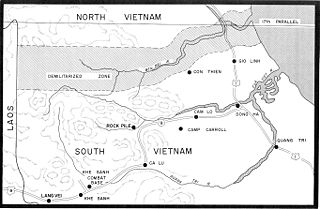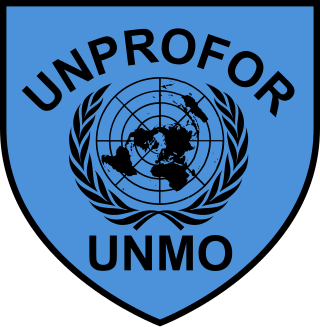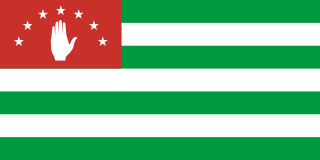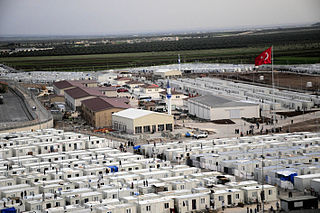Related Research Articles

A demilitarized zone is an area in which treaties or agreements between states, military powers or contending groups forbid military installations, activities, or personnel. A DZ often lies along an established frontier or boundary between two or more military powers or alliances. A DZ may sometimes form a de facto international border, such as the Korean Demilitarized Zone. Other examples of demilitarized zones are a 9-mile wide area between Iraq and Kuwait; Antarctica ; and outer space.

The United Nations Protection Force was the first United Nations peacekeeping force in Croatia and in Bosnia and Herzegovina during the Yugoslav Wars. The force was formed in February 1992 and its mandate ended in March 1995, with the peacekeeping mission restructuring into three other forces.

Operation Deliberate Force was a sustained air campaign conducted by the North Atlantic Treaty Organization (NATO), in concert with the United Nations Protection Force (UNPROFOR) ground operations, to undermine the military capability of the Army of Republika Srpska (VRS), which had threatened and attacked UN-designated "safe areas" in Bosnia and Herzegovina during the Bosnian War with the Srebrenica genocide and Markale massacres, precipitating the intervention. The shelling of the Sarajevo marketplace on 28 August 1995 by the VRS is considered to be the immediate instigating factor behind NATO's decision to launch the operation.

United Nations Safe Areas were humanitarian corridors established in 1993 in the territory of Bosnia and Herzegovina during the Bosnian War by several resolutions of the United Nations Security Council.

Danish Refugee Council (DRC) is a private Danish humanitarian nonprofit organization, founded in 1956. It serves as an umbrella organization for 33 member organizations.

United Nations Security Council resolution 819, adopted unanimously on 16 April 1993, after reaffirming resolutions 713 (1991) and all (1992) subsequent resolutions, the Council expressed concern at the actions of Bosnian Serb paramilitary units in towns and villages in eastern Bosnia and Herzegovina, including attacks on civilians, the United Nations Protection Force and disruption to humanitarian aid convoys. The resolution marked the UN's first civilian "safe area" being declared; it failed to prevent the Srebrenica massacre.

United Nations Security Council resolution 787, adopted on 16 November 1992, after reaffirming Resolution 713 (1991) and all subsequent resolutions on the topic, the council called upon the parties in Bosnia and Herzegovina to consider the draft outline constitution as a basis for negotiating a political settlement of the conflict in the country, and went on to impose further international sanctions on the Federal Republic of Yugoslavia.

United Nations Security Council resolution 859, adopted unanimously on 24 August 1993, after recalling all resolutions on the situation in Bosnia and Herzegovina, the council noted that, despite all previous security council resolutions since Resolution 713 (1991), the region was still a scene of hostilities and there was little compliance with previous resolutions, particularly by the Bosnian Serb party.

United Nations Security Council resolution 892, adopted unanimously on 22 December 1993, after reaffirming resolutions 849 (1993), 854 (1993), 858 (1993), 876 (1993) and 881 (1993) on the Georgian–Abkhazian war and Resolution 868 (1993) concerning the safety of United Nations peacekeepers, the council discussed the phased deployment of 50 military observers in Georgia.

United Nations Security Council resolution 998, adopted on 16 June 1995, after reaffirming all resolutions on the conflicts in the former Yugoslavia, in particular Resolution 982 (1994), the council established a rapid reaction force of up to 12,500 personnel within the United Nations Protection Force (UNPROFOR) in Bosnia and Herzegovina following attacks on it and the overall deteriorating situation.

United Nations Security Council resolution 1010, adopted unanimously on 10 August 1995, after recalling all resolutions on the situation in the former Yugoslavia and reaffirming Resolution 1004 (1995), the Council demanded that the Bosnian Serbs release all detained persons and permit access to them by international humanitarian organisations.

United Nations Security Council resolution 1078, adopted unanimously on 9 November 1996, after expressing concern at the situation in the African Great Lakes region, the Council discussed proposals for a regional conference on security and a multinational humanitarian force in eastern Zaire.
United Nations Security Council resolution 1199, adopted on 23 September 1998, after recalling Resolution 1160 (1998), the Council demanded that the Albanian and Yugoslav parties in Kosovo end hostilities and observe a ceasefire.

The siege of Bihać was a three-year-long siege of the northwestern Bosnian town of Bihać by the Army of the Republika Srpska, the Army of the Republic of Serbian Krajina and Bosnian Muslim dissenters led by Fikret Abdić during the 1992–95 Bosnian War. The siege lasted for three years, from June 1992 until 4–5 August 1995, when Operation Storm ended it after the Croatian Army (HV) overran the rebel Serbs in Croatia and northwest of the besieged town.

The Syrian civil war is an ongoing multi-sided conflict in Syria involving various state-sponsored and non-state actors. In March 2011, popular discontent with the rule of Bashar al-Assad triggered large-scale protests and pro-democracy rallies across Syria, as part of the wider Arab Spring protests in the region. After months of crackdown by the government's security apparatus, various armed rebel groups such as the Free Syrian Army began forming across the country, marking the beginning of the Syrian insurgency. By mid-2012, the crisis had escalated into a full-blown civil war.

Humanitarian aid during the Syrian civil war has been provided by various international bodies, organizations and states. The main effort is coordinated by Jonh Ging of the United Nations Office for the Coordination of Humanitarian Affairs (UNOCHA). In 2014, U.N. Security Council Resolution 2165 authorised humanitarian aid to be supplied via four border crossings not controlled by the Syrian government, generally to supply rebel-controlled territory.

Safe zones, de-escalation zones or no-fly zones have been proposed or created at various points during the Syrian civil war which began in 2011, including "de-escalation zones" agreed between the Turkish and Russian powers backing various belligerent parties and no-fly zones proposed in the Kurdish Northeast and rebel Northwest of the country.

The siege of Eastern Ghouta was a siege that was laid by Syrian Government forces in April 2013, to the area in eastern Ghouta held by anti-government forces since November 2012, during the Syrian civil war. The cities and villages under siege were Douma, Mesraba, Arbin, Hamouria, Saqba, Modira, Eftreis, Jisrin, as well as suburbs of Damascus Beit Sawa, Harasta, Zamalka, Ein Tarma, Hizzah and Kafr Batna. By 2016, around 400,000 people were trapped in an area just over 100 square kilometres in size, thus with a population density around 4,000 inhabitants/km2.

Turkey's migrant crisis, sometimes referred to as Turkey's refugee crisis, was a period during the 2010s characterised by a high number of people migrating to Turkey. Turkey received the highest number of registered refugees of any country or territory each year from 2014 to 2019, and had the world's largest refugee population according to the United Nations High Commissioner for Refugees (UNHCR). The majority were refugees of the Syrian Civil War, numbering 3.6 million as of June 2020. In 2018, the UNHCR reported that Turkey hosted 63.4% of all "registered Syrian refugees."
Humanitarian aid in conflict zones is the provision of emergency assistance and support to individuals and communities affected by armed conflict, with the aim of alleviating suffering, maintaining human dignity, and preserving life. This type of aid encompasses a wide range of services, including but not limited to, the delivery of food, water, shelter, medical care, and protection services, and is delivered amidst challenging and often dangerous conditions, with the goal of reaching those most in need regardless of their location, political affiliation, or status.
References
- ↑ "Security Council hears conflicting Russian, Georgian views of worsening crisis". United Nations Security Council. Archived from the original on 12 September 2013. Retrieved 14 March 2012.